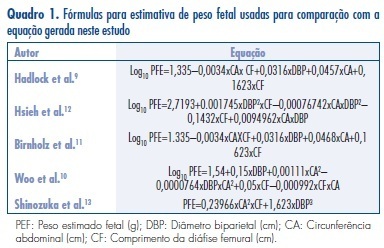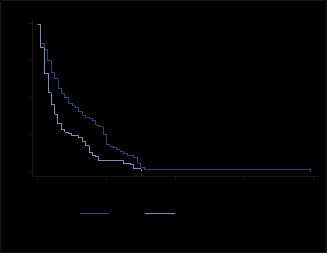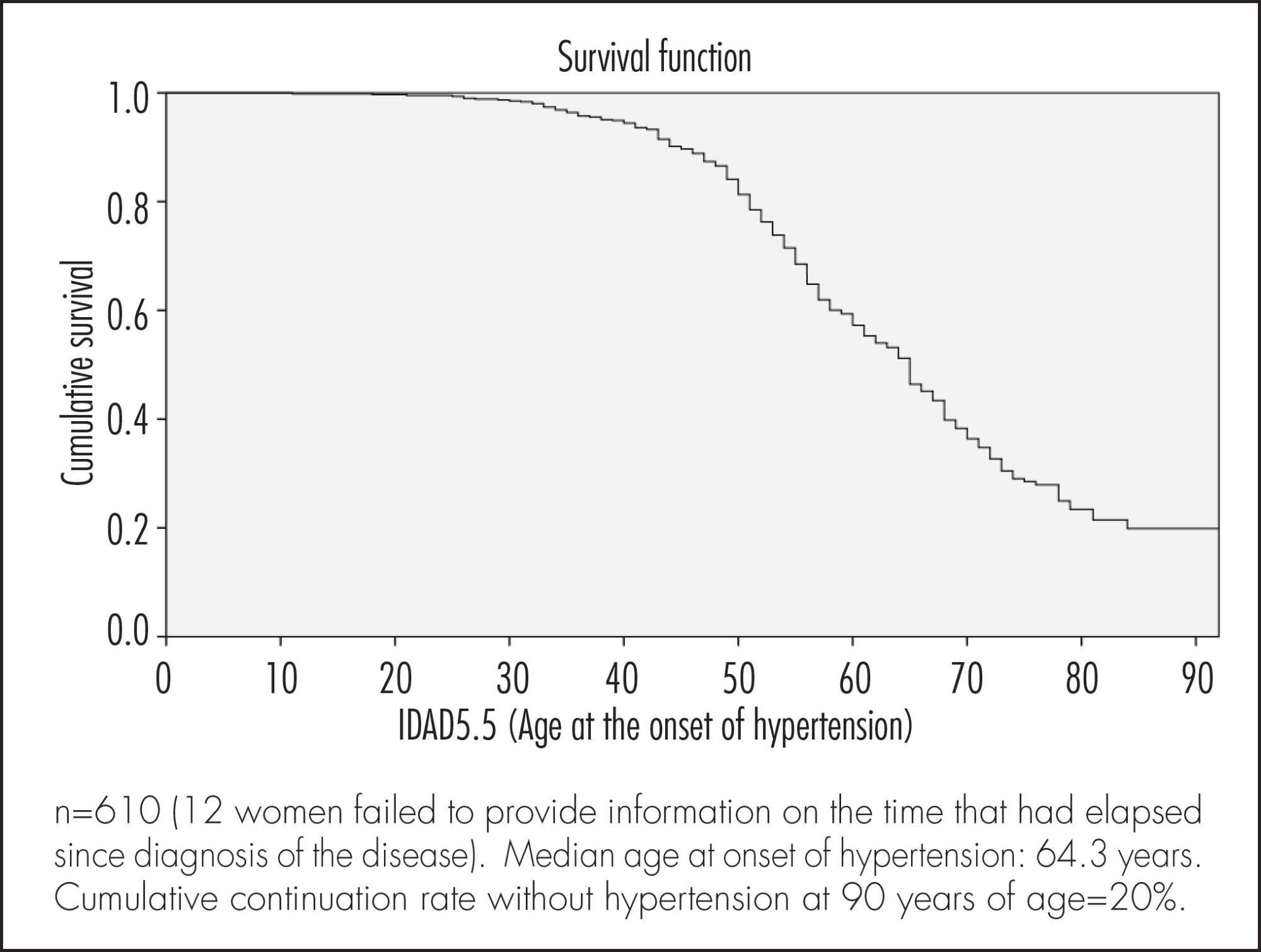Summary
Revista Brasileira de Ginecologia e Obstetrícia. 2012;34(10):466-472
DOI 10.1590/S0100-72032012001000006
PURPOSES: To elaborate models for the estimation of fetal weight and longitudinal reference intervals of estimated fetal weight (EFW) using a sample of the Brazilian population. METHODS: Prospective observational study. Two groups of patients were evaluated: Group EFW (estimation of fetal weight): to elaborate (EFW-El) and validate (EFW-Val) a model for the prediction of fetal weight; Group LRI (longitudinal reference intervals): To elaborate (LRI-El) and validate (LRF-Val) conditional (longitudinal) percentiles of EFW. Polynomial regression analysis was applied to the data from subgroup EFW-El to elaborate a model for the estimation of fetal weight. The performance of this model was compared to those of previously published formulas. Linear mixed models were used for the elaboration of longitudinal reference intervals of EFW using data from subgroup LRI-El. Data obtained from subgroup LRI-Val were used to validate these intervals. RESULTS: Group EFW consisted of 458 patients (EFW-El: 367; EFW-Val: 91) and Group LRI consisted of 315 patients (LRI-El: 265; LRI-Val: 50). The model obtained for EFW was: EFW=-8.277+2.146xBPDxACxFL-2.449xFLxBPD². The performances of other models were significantly worse than those obtained with our formula. Equations for the prediction of conditional percentiles of EFW were derived from the longitudinal observation of patients of subgroup LRI-El and validated with data from subgroup LRI-Val. CONCLUSIONS: We described a method for customization of longitudinal reference intervals of EFW obtained using formulas generated from a sample of the Brazilian population.

Summary
Revista Brasileira de Ginecologia e Obstetrícia. 2008;30(9):466-469
DOI 10.1590/S0100-72032008000900007
Heterotopic gestation, characterized by the presence of combined topic and ectopic gestation, until recently was considered to be a rare event occurring in 1:30,000 pregnancies. With the appearance of assisted reproduction techniques, this incidence increased to 1:100-500 gestations. Early diagnosis is difficult and frequently is made when the uterine tube has already ruptured. It's presented a case of heterotopic pregnancy diagnosed by means of a clinical presentation of hemorrhagic acute abdomen, with good progression of the topic gestation that resulted in birth. It's pointed out the importance of considering this pathology in the evaluation of women submitted to in vitro fertilization, with the objective of early treatment.
Summary
Revista Brasileira de Ginecologia e Obstetrícia. 2021;43(6):467-473
To assess the sexual function of women with spina bifida (SB), and to verify the factors that influence their sexual function.
A cross-sectional study in which a validated female-specific questionnaire was applied to 140 SB female patients from four different cities (Porto Alegre, Brazil; and Barcelona, Madrid, and Málaga, Spain) between 2019 and 2020. The questionnaires collected data on the clinical characteristics of SB, and female sexual function was assessed using the 6-item version of the Female Sexual Function Index (FSFI-6) validated to Portuguese and Spanish.
Half of the patients had had sexual activity at least once in the life, but most (57.1%) did not use any contraception method. Sexual dysfunction was present in most (84.3%) patients, and all sexual function domains were impaired compared those of non-neurogenic women. The presence of urinary and fecal incontinence significantly affected the quality of their sexual activity based on the FSFI-6.
The specific clinical aspects of the SB patients, such as urinary and fecal incontinence, should be properly addressed by their doctors, since they are associated with reduced sexual activity and lower FSFI-6 scores in the overall or specific domains. There is also a need to improve gynecological care among sexually-active SB patients, since most do not use any contraceptive methods and are at risk of inadvertent pregnancy.

Summary
Revista Brasileira de Ginecologia e Obstetrícia. 2006;28(8):467-472
DOI 10.1590/S0100-72032006000800005
PURPOSE: to assess human T-cell lymphotropic virus type I (HTLV-I) seroprevalence among pregnant women attended at Public Health Units in Goiânia-Goiás and some epidemiologic characteristics of the studied group. METHODS: from September/2003 to December/2004, 15,485 pregnant women were submitted to enzyme-linked immunoabsorbent assays (ELISA), to screen HTLV-I, using filter paper - dried blood in, and to confirm the infection, polymerase chain reaction (PCR) of whole blood was performed. The epidemiologic factors evaluated were: average age, age of 30 years and above, schooling less than nine years, marital status and number of pregnancies. The factors average age, age of 30 years and above, and schooling less than nine years were compared between the infected and non-infected pregnant group. Statistical analysis used Fisher's exact test and Student's t test. RESULTS: the found prevalence was 0.1%. The average age among the infected pregnant group was 26.4 years, 43.7% of them being 30 years old and above, and 62.5% with schooling less than nine years. The non-infected group showed an average age of 24.4 years, 15.4% of them being ³ 30 years old and above, and only 41.5% with schooling less than nine years. Significant statistical difference was noticed only regarding age of 30 years and above and schooling less than nine years. CONCLUSION: the study shows that HTLV-I seroprevalence among pregnant women in Goiânia during the studied period was 0.1%. It occurred more among pregnant women who were 30 years old and above and those with schooling of less than nine years.
Summary
Revista Brasileira de Ginecologia e Obstetrícia. 2015;37(10):467-472
DOI 10.1590/SO100-720320150005440
The administration of a single-course antenatal corticosteroid treatment is recommended for pregnant women between 24 and 34 weeks with risk of premature birth. The maximum effect is achieved when antenatal corticosteroids are administered between 24h and 7 days before delivery. The objective of this study was to evaluate the occurrence of birth within seven days of corticosteroid therapy in major obstetric situations with risk of preterm birth
Retrospective cohort study including 209 pregnant women hospitalized in risk of preterm delivery, submitted to corticosteroid therapy for fetal lung maturation. The study was carried out between January 2012 and March 2014 at a university hospital. Main outcome measure was the number of women who delivered within 7 da ys after antenatal corticosteroid administration. Two groups were defined according to the reason for starting corticosteroids: threatened preterm labour (Group APPT) and other indications for corticosteroid therapy (Group RPPT). A Kaplan-Meier survival analysis was performed and a p value <0.05 was considered statistically significant.
46.4% (n=97) of pregnant women gave birth in the seven days following corticosteroid administration. Delivery within 7 days occurred more frequently on group 2 in comparison to group 1 (57.3 versus42.4%; p=0.001). There is a statistically significant difference between the survival curve for groups 1 and 2, with a hazard ratio for delivery within 7 days 1.71 times higher for group 2 (95%CI 1.23-2.37; p<0.001)
It can be concluded that the probability of an event (birth within 7 days after corticosteroids) is smaller in the group of pregnant women admitted in the context of threatened preterm labor than for other indications. The use of corticosteroids in pregnant women admitted for suspected preterm labor should be subject to rigorous clinical evaluation

Summary
Revista Brasileira de Ginecologia e Obstetrícia. 2014;36(10):467-472
DOI 10.1590/SO100-720320140005094
To evaluate factors associated with hypertension in Brazilian women of 50 years of age or more.
A cross-sectional population based study using self-reports. A total of 622 women were included. The association between sociodemographic, clinical and behavioral factors and the woman's age at the onset of hypertension was evaluated. Data were analyzed according to cumulative continuation rates without hypertension, using the life-table method and considering annual intervals. Next, a Cox multiple regression analysis model was adjusted to analyze the occurrence rates of hypertension according to various predictor variables. Significance level was pre-established at 5% (95% confidence level) and the sampling plan (primary sampling unit) was taken into consideration.
Median age at onset of hypertension was 64.3 years. Cumulative continuation rate without hypertension at 90 years was 20%. Higher body mass index (BMI) at 20–30 years of age was associated with a higher cumulative occurrence rate of hypertension over time (coefficient=0.078; p<0.001). Being white was associated with a lower cumulative occurrence rate of hypertension over time (coefficient= -0.439; p=0.003), while smoking >15 cigarettes/day was associated with a higher rate over time (coefficient=0.485; p=0.004).
The results of the present study highlight the importance of weight control in young adulthood and of avoiding smoking in preventing hypertension in women aged ≥50 years.

Summary
Revista Brasileira de Ginecologia e Obstetrícia. 2019;41(8):467-468
Summary
Revista Brasileira de Ginecologia e Obstetrícia. 2005;27(8):467-472
DOI 10.1590/S0100-72032005000800006
PURPOSE: to evaluate the prevalence of subclinical hypothyroidism and its effects on lipidic profile and bone mineral density (BMD) in postmenopausal women. METHODS: a cross-sectional study with survey of data from medical records of patients attended at a climacteric outpatient clinic. Inclusion criteria: postmenopausal women with measured thyroid-stimulating hormone (TSH) and free thyroxin (T4-L). Exclusion criteria: hyperthyroidism and thyroid cancer. Values of TSH >5.0 mIU/ml and normal T4-L were considered to be subclinical hypothyroidism. The 329 selected women (55.2±6.4 years) were divided into three groups: normal thyroid function (control) (n=208), subclinical hypothyroidism (n=53) and clinical hypothyroidism under treatment (n=59). Clinical data, hormonal therapy use, body mass index (BMI=kg/m²), lipid profile (total cholesterol, HDL, LDL, triglycerides) and BMD of lumbar column and femur were obtained. RESULTS: subclinical hypothyroidism was diagnosed in 16.1% of the cases. The groups were homogeneous regarding clinical features, BMI or lipidic profile. BMD in lumbar column and femur was lower in subclinical and clinical hypothyroidism than in euthyroidism (p<0.001). There was a negative correlation between values of TSH and BMD of lumbar column and femur (p<0.001). There was no correlation between TSH values and age, menopause time, BMI, and lipid profile. The total of hormonal therapy users was 65.1%, mean duration of 3.43±2.42 years, not differing between the groups. CONCLUSION: subclinical hypothyroidism with prevalence of 16.1% in postmenopausal women was associated with lower BMD, with no effects on lipid profile.